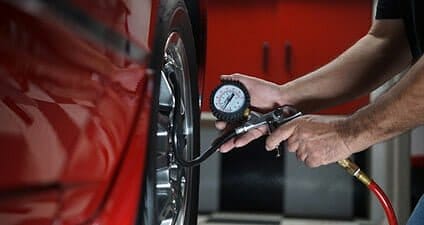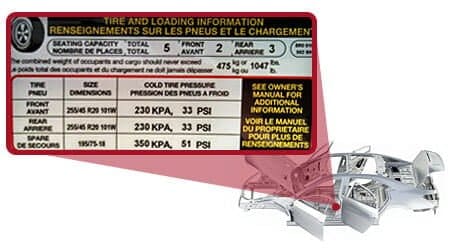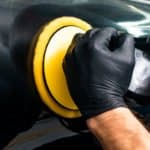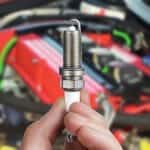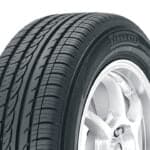Affiliate Disclosure: Some of the links in this post are affiliate links. As an Amazon Associate, we earn from qualifying purchases. Read more in our affiliate policy.
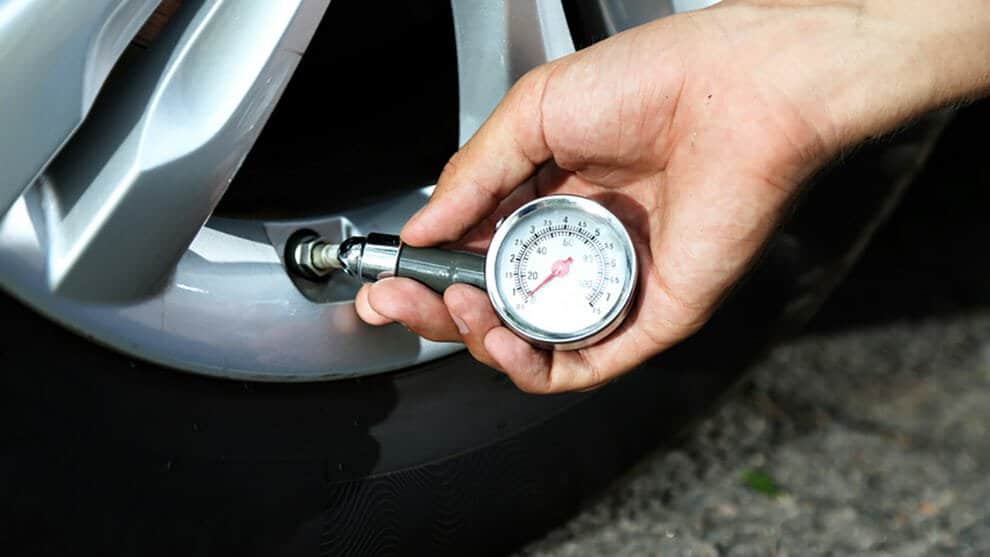
Best Tire Pressure Gauge: We’ve Tried Them All, The Most Accurate is…
In order to get the best gas mileage, your car needs to have the right tires, inflated to the right pressure. The right tires don’t change all that much, once you have done your research and gotten a good set on your car you are good for a while. Keeping them inflated needs a little more attention. Luckily the only tool that you need to have on hand is the right gauge. We are here to help you choose the best tire pressure gauge possible. Why does it matter?
Making sure you properly inflate your tires is one of the most important things you can do for them. And a good tire pressure gauge will make sure you do this accurately and remove any guess work. Inflated tires are great for fuel economy and your vehicle’s overall health. But how do you pick the right gauge?
Well, even the most accurate tire pressure gauge isn’t overly expensive, it isn’t difficult to use and can get you an answer very quickly. In this article, we’ll not only highlight six of the best tire gauges on the market today, but then we’ll dig deep into the subject. The buyer’s guide part will cover the important points to keep on your mind while you are looking for the one that is just right for you and your needs.
Best Tire Pressure Gauge – Our Top Picks Compared
| editors-choice | Best Product | Best Value | ||||
|---|---|---|---|---|---|---|
| item-title | TEKTON 5941 Digital Tire Gauge | Accutire MS-4021B Digital Tire Pressure Gauge | TireTek Premium Tire Pressure Gauge with Integrated Hold Valve | Accutire MS-4350B Setpoint Tire Gauge | Milton S-921 Passenger Car Tire Gauge | Astro 3018 Digital Tire Pressure Gauge and Inflator with Stainless Steel Braided Hose |
| item-review | read review | read review | read review | read review | read review | read review |
| Best Digital Tire Pressure Gauge | Most Accurate Tire Pressure Gauge | Best Analog Tire Pressure Gauge | Programmable Tire Pressure Gauge | Best Pencil Tire Pressure Gauge | Best Tire Inflator Pressure Gauge | |
| Type Digital | Type Digital | Type Analog / Dial | Type Digital | Type Pencil | Type Inflator Gauge |
|
| Pressure Range 0 to 100 PSI | Pressure Range 0 to 100 PSI | Pressure Range 0 to 60 PSI | Pressure Range 5 to 99 PSI | Pressure Range 5 to 50 PSI | Pressure Range 3 to 175 PSI |
|
| • Accurate and Easy • Light at Night • Ergonomic Design • Nozzle seals to valve stem • 30-second shut off | • Durable rubber grip handle • Rugged design • Accuracy: +/- 1% + 0.5 PSI • Easy to read, backlit, extra large display • Auto shut off • Replaceable battery included | • Calibrated to ANSI B40.1 Grade B (2%) • Steel and brass construction • No batteries required • Easy to read large scale dial | • Programmable Pressure Memory • White LED Flashlight • Auto Shut-off • Backlit Display • Replaceable Battery | • Single head chuck • Includes deflator valve • Made in USA | • Rugged and Precise Design • Easy To Install Battery Port • Durable Steel Braided Hose • Lock-On Air Chuck • Auto shut-off • Units: PSI/bar/kpa/kgf • Resolution: 0.1 PSI |
|
| td-btn-amz | Check Price at Amazon | Check Price at Amazon | Check Price at Amazon | Check Price at Amazon | Check Price at Amazon | Check Price at Amazon |
| editors-choice | Best Product | Best Value |
Tire Pressure Gauge Reviews – Which one is the Best?
Since you are here looking for the best tire gauge, we at GarageChief.com have done the legwork for you. We have managed to round up six of the top models currently on the market for you to consider. In doing so we have highlighted the price, type and pressure range to give you a quick comparison in our tire pressure gauge review below.
Before you continue, try to consider what is most important for you in a tire gauge. This means your preferred price range, functionality, and more. Then as you are reading through this buyer’s guide you can compare it to your individual needs.
After our top choices, we have a more detailed write up of each to give you a feel for each particular option. We have also flagged the stand out in our opinion for the best product and the best value of the group.
TEKTON 5941 – Best Digital Tire Pressure Gauge
- Price: Approx. $11
- Type: Digital
- Pressure Range: 0 to 100 PSI
If you are looking for the best digital tire pressure gauge look no further than our pick for the best product in our tire gauge roundup, the TEKTON 5941 Digital Tire Gauge. This is designed to be sleek and comfortable to hold in your hand. One of the top features of this particular set up is the light. Since you have a battery to read the pressure, TEKTON has added a light not only on the screen so that you can read the pressure, but also sports a light to help you find the valve stem at night.
And this is a gauge that reads in 4 different units, PSI reading, bar, kPa and Kg/cm2. This means that no matter what unit you find yourself using to measure the pressure in your tires you will be able to not only measure it, but get an exact measurement in 0.5 PSI increments. Then in order to save battery power, you’ll love the 30-second automatic shutoff. Lastly, this gauge comes with a nozzle that forms a quick and secure seal. This ensures that you will be able to check your tire pressure quickly and easily.
This is an excellent tire gauge at an affordable price, and some will understandably just prefer the digital nature of this product. Digital gives out easier readings and you will be happy should you ever need to use this product at night time.
TireTek With Integrated Hold Valve – Best Analog Tire Pressure Gauge
- Price: Approx. $15
- Type: Dial
- Pressure Range: 0 to 60 PSI
The TireTek Premium Tire Pressure Gauge with Integrated Hold Valve is our pick for the best value product. This dial style has a number of big advantages that make it the best analog tire pressure gauge on the market today. For starters, this gauge ranges from only 0 to 60 PSI. While other dial gauges claim to go all the way up to 100 PSI or more, with the lower range you can more clearly see what the pressure of your tire is at. Since most car tires have an optimum range in the 30 PSI range, this gauge covers your needs and will cover overages.
This gauge is built to heavy-duty standards, so that the company can claim that it will be accurate to within 2%, meaning that you will be getting a very high-quality tool for quite a reasonable price. For ease of use, this gauge has a 45-degree tilt and a fully swiveled chuck. This means that you can easily turn this into a view of your pressure no matter where the valve stem is.
This is a durable, functional product that comes in at a very affordable price. If you are looking for a product that just works, then this analog gauge is a great choice.
Accutire MS-4021B Accurate Tire Pressure Gauge, Digital
- Price: Approx. $12
- Type: Digital
- Pressure Range: 5 to 150 PSI
If you at in the market for a different style of digital gauge, consider the Accutire MS-4021B Digital Tire Pressure Gauge. This gauge sports a heavy duty construction and is covered with a rubber coating for an easy and non-slip grip. The head is angled to make it easier to connect to the tire while holding the device. The LCD screen lights up with red numbers letting you know the pressure of the tire even on a moonless night in the middle of nowhere.
This gauge is rated to 1% accuracy and can measure changes in 0.5 PSI increments, making sure you get the most precise reading. While some might balk at the fact that this tire gauge only reads down to 5 PSI instead of going all the way down to zero, in reality and for practical purposes when reading a tire’s pressure, 5 PSI is about as good as zero. This model also sports an automatic shut off to ensure that you don’t put it down and burn through all of your battery life. Also, with the minimal powered components, a set of batteries will end up lasting you for years to come.
Accutire MS-4350B Setpoint Tire Gauge
- Price: Approx. $15
- Type: Digital
- Pressure Range: 5 to 99 PSI
Another great offering from Accutire in the world of digital tire pressure gauges is the Accutire MS-4350B Setpoint Tire Gauge.
This is a digital tire gauge that comes with a number of bells and whistles to make the process of checking your tire pressure as simple and easy as possible. The first difference you will notice between this gauge and other digital offerings is the screen. While many digital tire gauges merely have a small LCD display to show a number, this one sports a good sized screen. It is lit with blue light to make it easy to view even if there is no other light in the area.
And that screen doesn’t stop at just displaying the reading. You can program in the desired optimal pressure for both your front and rear tires, meaning that when you get a reading your gauge will also display what the pressure should be. This means not having to memorize tire pressures or go attempting to find the optimal pressure level. This will help you to reach the optimal inflation pressure, and also help to avoid over-inflated tires. You can quickly refer to the gauge to know where you stand.
This is another great digital option if you are looking for ease of use above all else. It has all the functionality of a great tire gauge, but the simplicity of the design is what truly sets it apart.
Milton S-921 – Best Pencil Tire Pressure Gauge
- Price: Approx. $6
- Type: Pencil Gauge
- Pressure Range: 5 to 50 PSI
If you are looking for a low-cost option then you really need to consider the Milton S-921 Passenger Car Tire Gauge. While the price tag for this one is in the single digits, you shouldn’t be confused, this is probably the best pencil tire pressure gauge on the market. It is solidly built with a single head chuck for ease of use. Plus, it sports a deflator valve to make it simple to dump off extra pressure if you find that you have overinflated your tires.
And this gauge is marked in two sets of units. You’ll find the markings running from 5 to 99 PSI but you’ll also find the gauge is marked in Kilopascals. This set runs from 40 all the way to 350 for your measuring convenience. Of course, one of the top reasons to go with the pencil style gauge is the ease of carrying. Taking up no more space than a normal pencil, this important piece of kit ensures that you are able to check your pressure no matter where you find yourself and your tire.
This is a cheap, no-frills option that gets the job done. The portability is a huge bonus as well, and this might be the gauge for you if you are looking to easily bring your device wherever you go.
Astro 3018 Best Tire Inflator Pressure Gauge with Stainless Steel Braided Hose
- Price: Approx. $60
- Type: Inflator Gauge
- Pressure Range: 0 to 175 PSI
One of the frustrating things about inflating your tire is adding some air, then disconnecting and pulling out the gauge to check to see how close you are. Luckily, some companies, such as Astro have been addressing that problem.
They offer the Astro 3018 Digital Tire Pressure Gauge and Inflator with Stainless Steel Braided Hose. This is probably the best tire inflator pressure gauge that money can buy. You simply attach it to your compressor and then you can start filling and monitoring the pressure in your tire without swapping equipment.
One of the great features of this set up is that instead of some obscure battery this is powered by the standard AAA. And the battery set should yield 140 hours of use. This gauge is also dialed in to register increments of 0.1 PSI, making it a bit more precise than most other gauges on the market. This means that you can dial in your pressure to an exacting level. It also has one of the largest ranges of a tire gauge that we have come across.
So if you are truly looking for a top-tier tire pressure gauge, and are willing to make the investment to do it, then this is your choice. If you do this work very often, or are very concerned with accurate readings, then you might want to take on the additional cost to save yourself the extra trouble. This one is really worth the investment.
Best Tire Gauge – Find Out More
The Basics
It is hard to pick out the best of anything if you don’t have a good amount of foundational information about the product. It is no different when you are looking for the best tire pressure gauge. With that in mind, we will give you a rundown of all the information you need to select the gauge that is just right for your needs and situation.
How a Tire Air Pressure Gauge Works
First, let’s go over how a tire air pressure gauge works. As you know, your car’s tires are filled with air. This allows for a smooth ride. Each tire will have both a maximum air pressure and a recommended pressure level printed on the outside of the tire. Going over the maximum with over-inflated tires could cause the tire to split or burst. Going too low can cause the tire to wear unevenly and decrease fuel economy. With that in mind, you can see how it is important to keep your tire right around the optimum pressure.
To read the pressure of the air inside your tire, you’ll first remove the cover from the valve stem. This is where you will attach the tire pressure gauge. As you put the gauge on the valve stem you will hear air leaving the tire. If you don’t press the gauge on completely, the tire will continue to lose air and you’ll cause it to go flat. Once the gauge is completely in place it will display the pressure in the tire. The specifics will vary based on each particular style.
What happens is that as the air leaves the tire into the gauge, the amount is measured. The gauge is able to take that measurement and display it to the user. It is important that you be able to trust the pressure that the gauge displays as the truth, and this is where a high quality tire gauge comes into play.
Verifying New Tire Gauge
When you start using a new gauge you will want to verify how well it reads. This can be done very simply. First, you will need a “truth source”. This can either be a tire that you know the correct pressure of or an older trusted gauge. You will want to take a measurement with the new gauge and compare it to your “truth source”. This will let you know how accurate your new gauge is. Multiple readings will give you a feel for the consistency of this new purchase. Once you are confident in its readings, you can have peace of mind that you will be able to inflate your tires to the correct pressure every time.
Where to Keep Tire Pressure Gauge
You will also need to give some thought to where to keep your tire gauge. There is a great deal to be said for the convenience of keeping it in your car, either in the glove box or the trunk. The problem with this plan is that extreme heat and cold can cause changes in your gauge’s performance. For the best and longest lasting life of your tire gauge, it is recommended that you leave the gauge somewhere that will stay at room temperature.
Tire Pressure vs. Temperature
Just as the temperature on the extreme ends can cause an issue with your gauge, it can also affect your tire’s air pressure. Pressure is affected by both the temperature and the volume of the container the gas is in. In the case of our tire, ethe volume of the container does not change. That is the tire itself. This means that the pressure inside a tire will change based on its temperature.
Remember, the pressure inside a tire will change based on temperature.
As the temperature drops so will the pressure. This can start having noticeable differences when the temperatures approach freezing. Often times, as temperatures drop overnight the tires will read a low pressure in the morning. During the day, as the temperature rises, the pressure will return to normal. The problem is that while the pressure is lower the tire isn’t sealed as well as normal. This means that some air will escape. Several colder nights in a row can lead to a tire losing a noticeable amount of air. Therefore, it is quite important to monitor your tires’ pressure during the colder days.
Types of Tire Gauges
Now that you have an idea about some basics of tire gauges, it is important to tackle some of the different styles of gauge that are on the market. Each of these types of gauge has its own pluses and minuses which we’ll go over here.
This style may be the simplest and the most common one on the market. It tends to look like a pencil with a ball on one end. The ball end is the one with the valve that gets connected to the tire. The over end of the tube has a plastic ruler that extends out. That ruler is marked such that it will show you the pressure in your tire. With very few internal pieces these are very stable options and tend to be a lower price option.
Some people will pass this style over since, because it is low cost and found all over, they think that these cannot be a reliable gauge. However, if you pick up a well made one this is the kind that can be counted on for years to come without having to worry about batteries or your gauge going out of alignment. As a bonus, it is highly portable and can be carried almost anywhere.
In recent years, companies have been putting out digital tire pressure gauges. These gauges connect to your tire in the same way as other traditional style gauges but differ in their display. These tend to use an LCD screen to display the pressure of the tire in question. There are some great things that come with this. For example, while some gauges are difficult to read the exact value, these digital gauges are simple to read and give you the exact pressure in your tire.
Now, this simplicity does come with a downside. Since you are working with an LCD screen you have to have a battery in order to get a reading. So, if your battery dies you can’t check your tire pressure. Also, these gauges tend to use a button style battery instead of something like a double-A, so many don’t have the right size spare on hand. However, some find these downsides worth it for the simplicity of having a reading displayed on a screen in a straight forward way.
If you are looking for a style that doesn’t require a battery, the dial style of the analog gauge is a great choice. This one tends to have a cable from the valve to the gauge, meaning that you can easily measure the pressure of your tire and read the gauge, no matter what direction the tire is or where the valve stem is pointed.
The round dial can be simple to read, however, depending on the range of gauge it can be very difficult to determine the exact value that your gauge is showing you. However, this is a good option if you don’t want to worry about batteries and simply want a gauge that works.
Perhaps one of the best options is going with one that is integrated right into your tire inflator. We’ve given you some details on them in our Tire Inflator Post, but they deserve a mention here as well. This style can give you a readout while inflating your tires. You need to stop inflating to get a reading, but you don’t need to disconnect your tire inflator and pull out your tire gauge.
Most of these will end up being a pencil style gauge. The integrated nature of the gauge does mean that it will cost a bit more than some of our other styles, but they can be a real time saver. So if you find yourself doing this kind of work very often, this device can save you a ton of time in the long run.
Check all tire inflator integrated gauges available at Amazon
What to Consider Buying Tire Pressure Gauge?
- Accuracy
- PSI Range
- Readability
- Price
When you first go buy a tire gauge you might just want to walk into the store and grab the one on the shelf. And yes, it will work fine, but after some time will it continue to work as well?
This is the difference between buying a tire gauge because it was there and finding the best tire gauge. Before we go too much further we should take a look at what factors you should consider in your quest for the one that you will end up using for years to come.
Accuracy and Consistency
The first point is accuracy, which should always be considered with consistency. Accuracy is how close to the truth something reads. In the case of our tire gauge, if you have a tire that is filled to 32 psi and test it with two different gauges, finding one gives a reading of 35 psi and one gives a reading of 23 psi, it is easy to tell that the one reading 35 psi is the more accurate of the two. It is important to note that a gauge can be accurate without being dead on. It is important to test for accuracy right when you get a new gauge, so you can go forward with peace of mind that the readings you are getting are correct.
That accuracy needs to be paired with consistency though. In our example, if the tire pressure were read 10 times with each gauge and the first swung between reading 25 psi and 37 psi while the second read 23 psi each time, you could see that the second is much more consistent. Also, in this example, you can see that having a less accurate more consistent gauge can be more helpful than an accurate gauge that is inconsistent. Of course, the top gauges will offer both.
PSI Range
The next point of consideration is that PSI range. This is an area that more is not always better. To find the best range for you, first, consider the optimum range for your tire. You will clearly want from zero up to that optimal range covered. It is also a good idea to have some more range above the optimal, so you can easily see not only if you are overinflated but also by how much. The question is how high does it need to go? Generally, if you have a tire that should be inflated to anything with three digits, you are probably going to need a specialized gauge.
Readability
With the question of range, you also get into readability. When you are looking at the gauge is it easy to tell the difference between 35 and 30? How about between 20 and 30? As you start looking at gauges you might see those that offer ranges from 0 to 200 psi, but on the dial how easily will it be to know if you are at 30 psi and should add a bit more once you’ve hit 32 psi and should stop?
Analog or Digital – Which One Should You Go?
Is the best digital tire pressure gauge the most accurate tire pressure gauge? Do you get a better reading with an analog gauge? The first thing is to make sure you are aware of the difference. The major differences is shown in how they display their results. Digital gauges will normally have an LCD display, while analog models have a range of displays, from dials to the pencil stick variety.
In the case of which is the best, you should consider both accuracy and consistency. Accuracy is a measure of how close to the truth you get. Consistency is a means of how much that accuracy changes. For example, if you have a gauge that reads 30 pounds when the truth is 32 pounds it is rather consistent. Generally, if you can only choose one, consistency is more important than accuracy. Though a highly inaccurate gauge won’t do a whole lot of good either.
The truth of the matter is that a quality analog or digital can give you both an accurate and consistent tire gauge. You’ll have to base your decision on some other factors. One is the method reading the pressure level. In the digital model, you get a clear view of the pressure, in analog options you can have a wide range of choices.
Another thing to consider is the fact that a digital option will need a battery to work (usually AAA size). If you leave the gauge in the car, cold nights could drain the battery and without that battery, you won’t be able to read your tire pressure. Analog models are good in the fact that they are ready to go, no matter what.
Therefore, between analog or digital it really comes down to personal preference. However, there is a wide range of quality options for both types, and it is really more important that, no matter which style you choose, you get one that is accurate and consistent. No matter your choice, you can find a great option.
How Often Do You Check Your Tire Pressure?
Many people don’t think about checking their tire pressure. They believe that if they look at the tire and it looks flat than that is their indicator. The problem with this thinking is that a tire can be lower than it should be and still not look “low”. Most tires for standard cars stay to inflate them to around 32 psi. But even as low as 20 psi a tire might not look like it needs more air added. Running tires that are under-inflated – as well as over-inflated – can start to damage your tires and cause uneven wear on them.
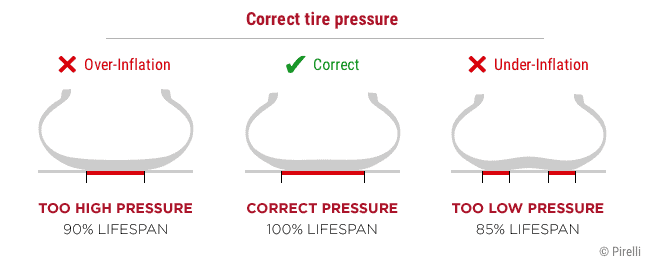
So, the question stands, how often should you be checking your tire pressure? The answer, as with so many things in the garage is that it depends. First, you will need to verify if your car a build in tire pressure monitoring system (TPMS). These electronic devices will routinely check your tire pressure. Some systems will only alert you if a tire is low, while others can display the pressure of each tire on an interior screen. If you have this style system you don’t need to check as often. Though it would not be bad to do a manual check every few months to verify that the system is working properly.
Without one of these systems, you will be relying solely on manual checks. In this case, you will want to do at least a monthly check. It is also a good idea to do a check prior to starting any long trips.
Lastly, you’ll need to be extra vigilant with your checks as the weather turns cold. On colder nights the air in your tire can contract, so if you were to check when you first got up, the pressure would be down. Also, while the pressure is low, the seals aren’t as tight, so some air may escape. Even if the tire pressure comes back up during the day it might not make it all the way back to the pressure it was the day before.
How To Use a Tire Pressure Gauge?
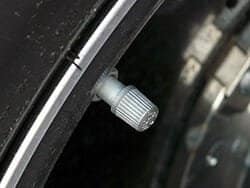
Often times this number will be in pounds per square inch PSI (Sometimes you can also find it in bars, but no worry, it’s easy to convert). The problem arises that this number is just a number until you know what it is telling you and what range the number should be. The number gives you an idea of how many pounds of force the air inside the tire is pressing on any given square inch of the tire.
Next, you’ll need to know what the number you should be getting from your tire pressure gauge. This can be found both on the outside of the tire and inside the driver side door (as always it’s also a good idea to read your car manual). The numbers on the tire can be right there while you are checking your pressure but can be harder to read. Luckily there should be a sticker on the driver side door that gives you both the maximum pressure and the optimum pressure.
An important thing to note is that sometimes the front and rear tires can have different maximum and optimal pressures. You will want to be sure of each for the best result. Also, the maximum pressure is the top that the tire can handle. It is not a wise idea to fill the tire to that pressure. The tire will last much longer if it is kept at the optimal level.
Now, if your tire reads at a level higher than the optimal amount you will need to remove air from the tire. The easiest way to do this is to unseat the gauge slightly until you hear the air rushing out of the tire. It is best to do this in small bursts so that you don’t let out too much air.
On the other hand, if your tire pressure is lower than optimal you’ll need to add some more. This is normally accomplished by use of an air compressor. There are some home based models that are solely for refilling tires. You can also use an air compressor that is attached to a tank that is designed for use with air tools, so long as you have the correct adapter.
If you don’t have either of these at home, many gas stations will have a tire fill station. Some are free to use at any time, some you merely have to get the head from the attendant and others you will have to pay a fee to use it. Many of these will have a pressure gauge on them so you can quickly check that you aren’t overfilling your tire. Some of the most modern options can actually let you set the desired pressure and the compressor will fill the tire until it hits that level.
How Much is A Tire Pressure Gauge?
As with any tool, one consideration needs to be the price involved. Luckily, when it comes to tire pressure gauges you don’t need to spend a whole lot in order to get a quality gauge. On the lower end of the spectrum, you can get a tool in the neighborhood of $5. Then again, if you are looking to go for something with all the bells and whistles, options can be had for $60 and up.
While you can easily get a tire pressure gauge at any number of stores from places like Target to auto parts stores, these locations will only have one or two options to select from. It is never a good idea to select a tool just because that is the only one that was on the shelf. In order to get a good selection, you will most likely have to look to a large online dealer.
Places like Amazon offer a very wide selection and even give good deals since they can deal with large numbers.
Tire pressure is not something that you want to mess around with. Having your tires inflated to the optimal pressure can not only keep your tires in top shape longer but will also be a better option for your car. A properly inflated tire is a safer option.
Visual inspection of your tires isn’t enough to let you know if you have your tire inflated correctly, you can’t even always trust that you have it in the ball park. Instead, you need to get a tire pressure gauge that you can trust. Once you find your perfect one, that is the one that you should keep working with so that even if your gauge isn’t spot on you’ll get a consistent reading across all your readings.
Best Tire Pressure Gauge -Bottom Line
At this point, you should have a solid foundation of what you need to know in the quest to track down the best tire pressure gauge. Our buyer’s guide has broken down the key features that need to on your mind while you think about your particular needs and situation. While in many of these situations,there is no one size fits all solution, so you will get to make a selection that will work best for you.
Some people don’t want to track down a great option and with that in mind, we have combed through the options in our review section given you six stand out options. In our opinion, the TEKTON 5941 Digital Tire Gauge is the top contender. With its ease of read out, it is sure to be a great addition to any garage, and it is very affordable as well.
Finally, we’d love to hear from you. Do you have some experience with our picks? If so would you let us know what you think about them in the comments section below?
Tire Pressure and its Influence on Tire and Car Traction.
https://www.youtube.com/watch?v=ITcmBhKJB6U
Last update on 2024-04-28 / Affiliate links / Images from Amazon Product Advertising API
Disclaimers
All product names, logos, and brands are property of their respective owners. All company, product and service names used in this website are for identification purposes only. Use of these names, logos, and brands does not imply endorsement.
It is our policy to make every effort to respect the copyrights of outside parties. If you believe that your copyright has been misused, please provide us with a message stating your position and we will endeavor to correct any misuse immediately.
Some of the links in this post are affiliate links. As an Amazon Associate, we earn from qualifying purchases. This means if you click on the link and purchase the item, we may receive an affiliate commission, at no extra cost to you. This helps us keep this website alive. Read more in our affiliate policy.
